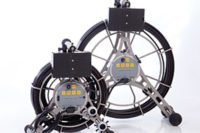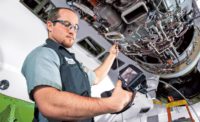Remote Visual Inspection equipment has existed since an inspector could pair a mirror with a flashlight. As Tom Ward, GE, RVI senior product manager, succinctly puts it, “People are always trying to look at something that they can’t get to, and they want to make a visual assessment of it.”
Luckily for today’s inspectors, modern videoscopes can help quickly view parts and flaws that, in the past, would have required lengthy and costly production halts, power plant shut-downs and grounded airplanes.
Early Development
Video borescopes were initially developed for the medical sector before being adapted for aviation and other industrial uses.
“It really was a transition from the medical side of gastro-intestinal scopes and the flexibility and maneuverability that it provided,” explains Frank LaFluer, Olympus product manager of RVI equipment for the Americas. “That’s really where the demand came from — to start using those types of technology to get to places that the rigid borescopes could not.
“As time went on, obviously the need for the medical sector is very different from the industrial; it had to become more durable. So when videoscopes began being possible both on the medical side and the industrial, that’s when [RVI] really came into its own. It started approaching the image quality of a rigid borescope and still had the flexibility and maneuverability that a fiberscope had. There were certain components and certain locations in an engine that honestly could not be seen with a rigid borsecope. There were many rotors that you would never be able to see because there weren’t ports located in every single location.”
In the beginning, the large, early videoscopes stretched the definition of the word “portable.”
“Honestly they used to be really big and the image quality wasn’t really great,” Ward says. “But the camera quality improved, as the image processing improved, monitors improved, and so on and so on.
“There’s been a lot of technical advancement that have made these really pretty incredible.”
Components
A typical videoscope has, at least, a battery power source, a handset and monitor, the probe itself, a light source, a CCD camera and imaging processing.
The most common probe diameter is 4 to 8 millimeters. For narrower passages, technicians can still use fiberscopes — which can be less than half of a millimeter in diameter — with the tradeoff being reduced image quality.
The videoscope probe itself often has a four-layer construction. On the inside is usually a coil, which is intended for crush resistance, according to LaFluer. It is surrounded by some sort of braid, whether it‘s stainless steel or tungsten, to provide torsion control. Around that is typically waterproofing from a synthetic. The final, outer later is then often metal or tungsten again to provide abrasion resistance.
There are different methods of articulating the device. One common design is for cables to be tied directly from the joystick to the head of the probe. Another way is to have the cables attached to little servomotors.
The advantage of tying the cables directly to the joystick is that some attendants sense more feel as they move the camera around to inspect, Ward says.
“The downside is it’s not as robust, it’s easier to break them. We (GE) use these articulation motors, where you’ll use the joystick to turn and these things turn little cams back and forth to move the thing where you want it to go.
“You tend to get more articulation that way. Meaning if I’m looking straight ahead I can articulate with our cameras all the way back 180 degrees or more. However, there are some folks that would say they’re not quite as sensitive. You don’t feel like you’d connected directly to the tip.”
A third method, used for longer probes, is pneumatic articulation. Short cables are attached to tubes, with a little balloon or bladder in between. As the balloon is inflated, it pulls on the cables and articulates it.
Other Features and Software
Inspectors have a handful of in-product software options and tools. Most products include systems for staying organized during an inspection. GE offers Menu Directed Inspection, which allows a customer to pre-build a software set that will identify the areas of the asset that they’re going to inspect and then drop in the images and any comments for annotation.
“Basically it saves the customer time because they don’t have to take the images, remember what they are, go back to the office, put them in the right order, try and remember what they did,” Ward says.
Videoscope makers also include measurement capabilities. The most common are stereo measurement and shadow measurement.
“If someone was inspecting an aircraft turbine they need to make sure [flaws] are within certain limits,” Advanced Inspection Technologies President Paul Fitzgerald explains. “If there’s a crack or a dent or some defect on a turbine blade, they need to check that and make sure it’s within those limits. If it’s not, then the engine has to be taken from the aircraft, and that costs time and money. And the longer that someone like a Delta Air Lines or American Air Lines can take their aircraft flying without taking engines off line, it’s just more profitable.”
Some complex videoscopes allow the user to adjust almost every aspect, like someone might with a consumer camera — from exposure, to brightness and color, among others — in order to obtain the best image quality.
“Those things were usually never available with fiberscopes,” LaFluer adds. “And there’s the other approach, where we’re trying to make it as simple as humanly possible, where you can literally go out there and push a button to take a picture without any settings or requirements. The vast majority will have features such as a white balance, and the ability to take pictures, take videos.”
The Market
Fitzgerald is seeing more RVI technicians in power generation and other non-aviation fields taking another look at push cameras as a more durable, less expensive alternative to videoscopes.
“They are designed specially to inspect heat exchanger tubes or boiler tubes,” he says. “And they do a much better job, and they’re faster and they don’t cost initially as much, and they don’t get damaged as easily as a videoprobes.
“And the mistake that a lot of people at these plants make is they try to purchase a videoprobe and they try to fit it into every possible application. When in truth they need several different instruments depending on what they’re inspecting.”
He said the necessity of choosing the right tool for the job has led to an increase in the rental market compared to the past.
“I think a lot of people have learned that a videoprobe may be great for inspecting turbines but it doesn’t do a very good job inspecting long pipes.”
He says the entrance of new competitors in the field has also changed the marketplace.
“There’s a lot more choice than there was five years ago,” he says. “And so that’s putting pressure on the price of the instruments, and hopefully it’s also affecting quality.”





